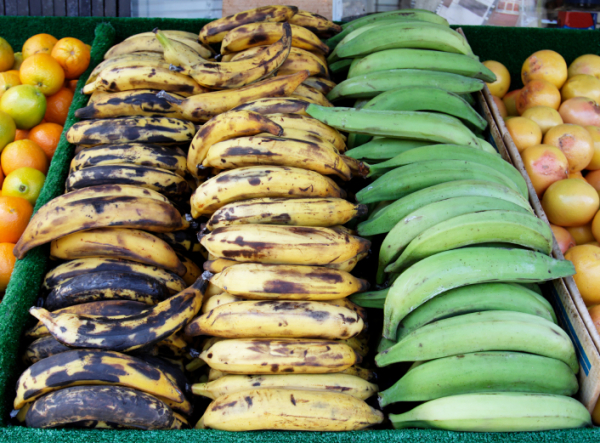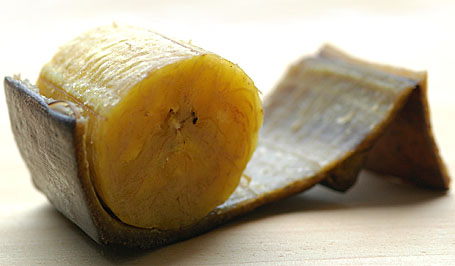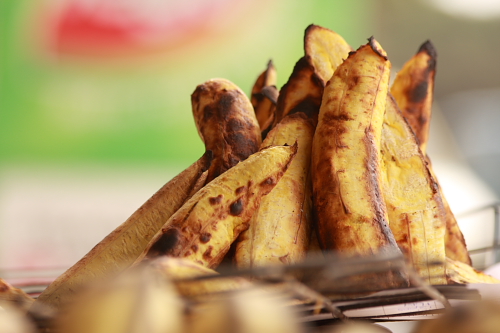 |
| No, these are not bananas! |
I made reference to plantains in my last blog post.
In Nigeria, plantain is eaten quite often, alone, with chips (french fries), with different rice dishes (when fried), with yams, sweet potatoes, anything but soups (but I eat it with leafy Nigerian soups instead of the "traditional" things those soups are eaten with (I can't stand those things), but I only eat Nigerian soups once in a long time (maybe once or twice a year, dunno)).
The semi-ripe (ripe) and ripe (very ripe) plantains (the plantains to the left and at the centre in the picture above) are usually the ones eaten. However, from time to time, my mum makes the unripe (green) one into some dish for me to eat because the unripe plantains are rich in iron and I am anaemic (iron-deficient).
Anyways, there are different ways plantains can be cooked. However, I am only going to talk about plantains being boiled, fried or roasted (not made with dishes). Below, I am going to describe how these are done:
Fried Plantain
 |
| This is what I ate a few days ago. |
To make this, you need to heat some oil up in a deep fryer. While the oil is being heated (to the maximum temperature (or about 190C), peel and cut the plantain into whatever shape you want (I have tutorial photos of this, but I can't get to them now). Put the cut plantain pieces into a bowl, add about a pinch of salt to the bowl (or more, depending on the quantity of plantain used) and toss and turn the bowl around. I usually put a lid on it and shake the bowl up and down, left and right, turn it around a bit and all.
 |
| Made it myself! |
Once the oil is heated fully, pour the plantain into the basket in the fryer, put the lid on the fryer and put the handle down so the plantains are submerged in the oil. Take the plantains out when they are about as brown as the ones I made in those pictures. Put them in a sieve-basket, on a cheese cloth or just shake the fryer basket a bit to get rid of most of the excess oil on the plantains and serve.
Be careful, the inner parts of the plantains will be really hot so you might want to leave them to cool for about a minute.
Boiled Plantain
When making "boiled" plantain, you need to have a pot with water boiling in it on the stove. While the water is heating up, you get out plantains and cut off their heads and tails (toss them in the trash). Leave the skin on the plantain and every few centimetres or every inch or so, you cut down on the plantain (or you don't even have to cut it, depending on how you want the plantain).
Place the plantain pieces in the pot of hot water, pouring some salt in after them and leave them in there (with the heat still on) until they are soft (but not WAY too soft). I have never cooked this, and the last time I ate it, I was a really little girl in Africa, but I'm guessing
about 15-20 minutes should do depending on how hot the water was when you tossed them in.
When the plantains are done, take them out of the pot and leave them out to cool for a bit. Make a slit in the skin of the plantain and peel it off then serve with a sauce of choice.
Roasted Plantain
No jokes, you can find this being cooked on the streets of Nigeria (well....the pavements/sidewalks) by ladies and that random spot where it is made is called, "Mama Put" (like "mama, put it in my plate!" unfortunately, it's served in newspapers and in the process of making it, fumes from vehicles and dust would've gotten on it, but that's not how I'm going to teach you to make it. We're going to make it household style.)

Cut of the head and tail of a plantain, peel the plantain and then toss it into an oven (about 200-250C) or pop it on a grill and let it cook till it looks like the pictures to the left. If the plantain is really ripe, let it get a bit darker. If you have a line of black (like the black parts on the plantain to the left of this), don't worry about it, but don't let the whole plantain go black!
Now, I'm going to get a pictorial for you guys to know how to peel a plantain and then I'll end this:
 |
| 1-2. Cut of the head and tail; 3. Make a slit with the tip of a knife down the length of one side of the plantain; 4. Pull up the skin from the slit; 5. Peel off the entire skin; 6. Get ready to cut or pop into the oven or on the grill! |
Thanks for reading!









